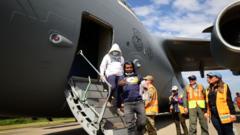The discovery of decades-old Nazi materials in the archives of Argentina's Supreme Court has prompted renewed interest in the country’s connections to World War II and the Holocaust. The court plans to conduct a thorough analysis of the documents to uncover potential historical insights.
Hidden Nazi Documents Discovered in Argentina Supreme Court Archives

Hidden Nazi Documents Discovered in Argentina Supreme Court Archives
Long-lost materials include propaganda and notebooks linked to Nazi ideology, leading to renewed investigations into Argentina's historical ties to World War II.
A routine archival project at the Argentina Supreme Court has unveiled a treasure trove of Nazi-era documents, sparking intrigue and concern over the country’s past ties to World War II. Staff clearing out the court's basement stumbled upon boxes filled with notebooks stamped with swastikas, along with countless propaganda materials reflective of Adolf Hitler’s ideology.
Stored for more than eight decades, these materials were discovered serendipitously while workers were organizing items for a future Supreme Court Museum. Upon reviewing the contents, court officials noted that the documents were intended to promote Nazi beliefs in Argentina during the war’s peak, a period when the nation maintained an official stance of neutrality.
In the wake of this unveiling, a ceremony was held for members of the Argentine Jewish community, historians, and officials, all eager to understand the implications of this significant find. The court's president, Horacio Rosatti, underscored the need for a comprehensive assessment of the documents, acknowledging their potential to shed light on events surrounding the Holocaust.
Jonathan Karszenbaum, the executive director of the Holocaust Museum in Buenos Aires, expressed astonishment at the scale of the discovery. He noted that this volume of historical documentation could significantly enhance the narrative of Nazi activities within Argentina.
Initial investigations confirmed that the boxes originated from the German Embassy in Tokyo, arriving in Argentina on June 20, 1941, aboard the Japanese ship Nan-a-Maru. This connection to Japan—who was allied with Nazi Germany at the time—hints at an intricate web of international relationships during the war.
As authorities begin to sift through these materials, many are left pondering the implications of these findings for both Argentina's history and the broader narrative of Nazi influence in the region during World War II.

















